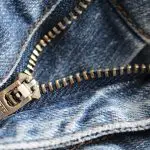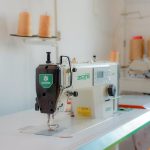You're on the final stretch of your sewing project, and just like tying a bow around a gift, finishing your stitch neatly is the perfect final touch. Mastering different ways to finish a stitch on your sewing machine gives your work a professional look and ensures it stays put.
From backstitching to using a locking stitch, there are several techniques to choose from. Let's explore five effective ways to finish your stitches and elevate the quality of your sewing projects.
Key Takeaways
- Backstitching and locking stitch are essential techniques for securing stitches and preventing unraveling.
- Stitching overlap can be achieved by carefully aligning the fabric under the needle and ensuring proper thread tension.
- Securing the end of a stitch with a knot reinforces the seam and adds extra security.
- Fray check can be used to prevent fraying and unraveling of fabric edges, but it should be applied sparingly to avoid stiffening the fabric.
Backstitching
To secure your stitches and prevent unraveling, backstitch at the beginning and end of your sewing line. Backstitching, also known as reverse stitching, is a crucial technique for stitch reinforcement. It involves sewing a few stitches forward, then reversing the machine to sew over the same stitches in the opposite direction. This creates a strong anchor at the beginning and end of your seam, preventing the stitches from coming undone.
When you reach the start of your sewing line, engage the reverse stitch button or lever on your machine. Sew about three to four stitches in reverse before switching back to forward stitching. This will lock the initial stitches in place.
As you approach the end of your sewing line, repeat the process by backstitching another three to four stitches. This simple yet effective technique will ensure that your stitches remain secure and the seam stays intact.
Locking Stitch
You should always use a locking stitch at the end of your sewing line to secure the stitches and prevent unraveling. Here's how to do it:
- Adjust the stitch tension: Before starting the locking stitch, ensure that the stitch tension is properly set. Proper tension ensures that the locking stitch effectively secures the end of the seam.
- Wind the bobbin: Make sure your bobbin is properly wound before beginning the locking stitch. A well-wound bobbin ensures that the locking stitch is strong and secure.
- Perform the locking stitch: Once you reach the end of your sewing line, engage the locking stitch function on your sewing machine. This will create a few extra stitches in place to secure the seam. Afterwards, trim the excess thread close to the fabric to complete the process.
Stitching Overlap
When stitching overlap occurs on a sewing machine, ensure that the needle penetrates the fabric at the exact point where the previous stitching ended. This is crucial to maintain a neat and professional finish. To achieve this, carefully align the fabric under the needle, making sure that the needle enters the fabric at the exact spot where the previous stitching concluded. Pay close attention to the stitching pattern as you guide the fabric through the machine. Keeping a steady hand and a watchful eye will help you maintain accuracy.
Additionally, it's important to consider the thread tension when dealing with stitching overlap. Proper thread tension ensures that the stitches are uniform and secure. Check your sewing machine's manual for instructions on adjusting the thread tension to suit your specific fabric and thread. Proper tension will prevent loose or tight stitches, ultimately contributing to a clean and polished final result.
Securing With a Knot
After managing stitching overlap with careful attention to the needle placement and thread tension, frequently securing the end of a stitch with a knot ensures a strong and professional finish. Here's how to do it:
- Hand stitching: When you reach the end of your seam, stop the machine with the needle in the down position. Lift the presser foot and pull the fabric towards the back to create a thread tail. Then, cut the thread, leaving a few inches to work with.
- Thread tension: To secure the stitch with a knot, use a hand-sewing needle to pull the thread tail through the loop, creating a small knot. Repeat this process once or twice for added security. Trim any excess thread, leaving a neat and tidy finish.
- Professional touch: Securing the end of your stitch with a knot not only reinforces the seam but also adds a professional touch to your sewing projects. It ensures that your hard work holds up over time, giving you confidence in the durability of your creations.
Fray Check Application
To apply fray check, carefully dab a small amount directly onto the edge of the fabric. This will prevent fraying and unraveling, ensuring a neat and professional finish to your sewing projects. Fray check provides several benefits, such as strengthening the fabric edge and preventing it from fraying during washing and wearing. When applying fray check, make sure to use it sparingly to avoid stiffening the fabric. After application, allow the fray check to dry completely before handling the fabric.
While fray check is a popular option, there are alternative methods to prevent fraying, such as using a zigzag stitch, serging the edges, or using fabric glue. However, when comparing effectiveness, fray check is often preferred for its ease of application and ability to provide a durable and long-lasting solution. It's important to consider the type of fabric and the intended use of the project when choosing the best method for finishing the fabric edges.
Frequently Asked Questions
Can I Use a Different Method to Finish My Stitch if I Don't Have a Backstitch Function on My Sewing Machine?
If your sewing machine lacks a backstitch function, consider alternatives like tying off the threads or using hand finishing techniques. These methods can secure your stitches without the need for a backstitch function.
What Should I Do if My Locking Stitch Doesn't Hold and My Stitches Start to Unravel?
Adjust your thread tension to ensure it's not too loose. Check your stitch length; longer stitches can unravel more easily. Experiment with different settings until you find the right combination for secure, durable stitches.
Is It Okay to Stitch Over the Same Area Multiple Times to Ensure a Secure Finish?
Yes, it's okay to stitch over the same area multiple times for a secure finish. This stitching technique provides reinforcement for the fabric, ensuring durability. It's a great way to strengthen seams and prevent unraveling.
How Do I Secure My Stitch With a Knot if My Sewing Machine Doesn't Have an Automatic Knotting Feature?
To secure your stitch without an automatic feature, try hand-sewing a knot or use alternative knotting techniques. These finishing touches will ensure a secure finish, even without an automatic knotting feature on your sewing machine.
Can I Use Something Other Than Fray Check to Prevent My Fabric From Fraying at the End of a Stitch?
You can use alternative methods like fabric sealing or knotting techniques to prevent fabric from fraying at the end of a stitch. Hand finishing with a whipstitch or backstitch also works well.
- How Does Ring Spun Cotton Affect Garment Fit and Shape Retention? - August 13, 2024
- What Are the Challenges in Producing Ring Spun Cotton? - August 13, 2024
- Is Ring Spun Cotton Suitable for Plus-Size Clothing? - August 13, 2024







